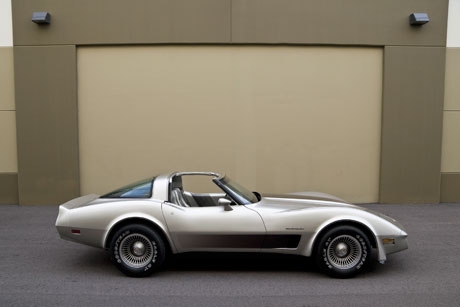Patterned after Larry Shinoda’s “Shark II” prototype, the third-generation Chevrolet Corvette production run started in 1968 and continued with few aesthetic modifications through the 1982 model year.
The final year of the C3 car offered factory “Cross-Fire” electronic fuel injection that gave them a boost for the first time in many years. The twin throttle body injectors looked somewhat like carburetors and were mounted diagonally on each side of a broad intake manifold. Cross-Fire’s higher level of sophistication added 10 horsepower, now to an even 200.
As this was also the body style’s last hurrah, a series of Commemorative Collector’s Edition Corvettes were released to mark the transition. These 6,759 cars differed from base models in several ways, including a higher level of standard features that were otherwise optional on base models. Special features on this rare car included a lifting rear hatchback glass window, special wheels, a unique silver/beige paint color combination against a contrasting silver/beige leather interior as well as special cloisonné emblems.
The interior is original and in excellent condition. The car retains almost all its original parts. The original wheels and tires were removed and stored long ago, so the original tires are in almost-mint condition.
SCM Analysis
Detailing
| Vehicle: | 1982 Corvette Collector Edition |
| Years Produced: | 1982 |
| Number Produced: | 6,759 |
| Original List Price: | $22,537.59 |
| SCM Valuation: | $16,800-$29,500 |
| Tune Up Cost: | $400 |
| Distributor Caps: | $29.95 |
| Chassis Number Location: | Stamped on the inner vertical surface of the left windshield pillar, and it is visible through the windshield |
| Engine Number Location: | Located on a boss on right front of engine block |
| Club Info: | National Corvette Restorers Society, National Council of Corvette Clubs, Corvette Collector Edition Registry |
| Website: | www.ncrs.org |
| Alternatives: | 1978 Corvette Indy Pace Car, 1978 Corvette Silver Anniversary Coupe, 1988 Corvette 35th Anniversary Limited Edition Coupe |
| Investment Grade: | C |
This car, Lot S626, sold for $21,450, including buyer’s commission, at Russo and Steele’s Scottsdale, AZ, auction on January 20, 2011.
1982 marked the end of the run for the “Sharks,” as the third-generation Corvette is affectionately known. With a lifespan of 15 years, this was Corvette’s longest- lived, most-successful generation—from the perspective of sales.
The Sharks started out in 1968, with a production of 28,566 units, jumping to 38,762 units in 1969 and reaching a peak of 53,807 units in 1979. More than 40,000 units were produced in 1976, 1977, 1978, 1980 and 1981. These Corvette production numbers have not been seen since the C3 Corvette was laid to rest in 1982. No question about it, the C3 Corvette was an unbridled sales success and testament to America’s love affair with the Corvette.
Farewell and hello
The 1982 model year might very well be considered a pivotal moment in Corvette history, as it not only marked the end of a significant chapter in the Corvette story, but, perhaps more importantly, it was a harbinger to where Corvette was headed.
The initial clues came in the form of the innovative drive train offered in the 1982 Corvette. For the first time since 1965, Corvette would install fuel injection in factory cars. Cross-Fire Injection—unlike the original fuel-injection systems used on Corvettes from 1957 to 1965—used twin throttle-body injectors with computerized metering and an electric fuel pump in the gas tank. The electronic control module that operated the system was capable of handling up to 80 adjustments per second in ignition timing, idle speed, air-fuel mixture, and so on to maximize performance and fuel efficiency, reduce emissions and provide the driver with instant throttle response.
Mated to the Cross-Fire system was the new 4-speed automatic transmission, which was electronically linked to the ECM and offered lockup function in every gear except first. This combination represented the pinnacle of technological innovation to be found under the hood of the Corvette up to that time. It clearly indicated the direction Corvette was taking to meet the challenges of the day.
A special look
To recognize the closing of the Shark era and the unveiling of the new technology being developed for the Corvette, Chevrolet decided to offer the 1982 Collector Edition model, of which 6,759 were produced, which was about 26% of the 1982 production.
While it offered no performance enhancements over the standard model, the Collector Edition was all about refinement and detail. The exterior was distinguished by its unique silver-beige finish, accented with graduated gray decals and accent striping applied to the hood and sides. The Corvette also had bronze-tinted glass roof panels, cloisonné emblems, and finned, cast-aluminum wheels, with white-lettered P255/60R15 Goodyear Eagle GT tires.
The interior sported silver-beige leather upholstery, a leather-wrapped steering wheel, leather-trimmed door panels, extra-plush carpeting, and a cloisonné emblem in the horn.
For the first time since 1962, the 1982 Collector Edition Corvette offered exterior access to the interior storage area by transforming the fastback rear window into a hatchback. At a cost of $22,538.00 ($4,248.00 above the base model), the Collector Edition had the distinction of being the first Corvette priced over $20k.
Condition and value
The market value of 1982 Collector Edition Corvettes over a standard 1982 Corvette varies from $5k to $8k—based on the car’s condition.
This car was an excellent example of a 1982 Collector Edition Corvette. This car was fully optioned, with the exception of CB radio and Gymkhana suspension, had 19,500 miles on the odometer, recently received a first-class repaint, offered good documentation (an original window sticker and original manuals)—and a 1991 Bloomington Gold Certificate.
This is pretty much as good as it gets for a 29-year-old Corvette that has seen limited road time. I believe the car was sold at fair market value. With continued moderate usage and proper care, this Corvette should see market appreciation in its future.
